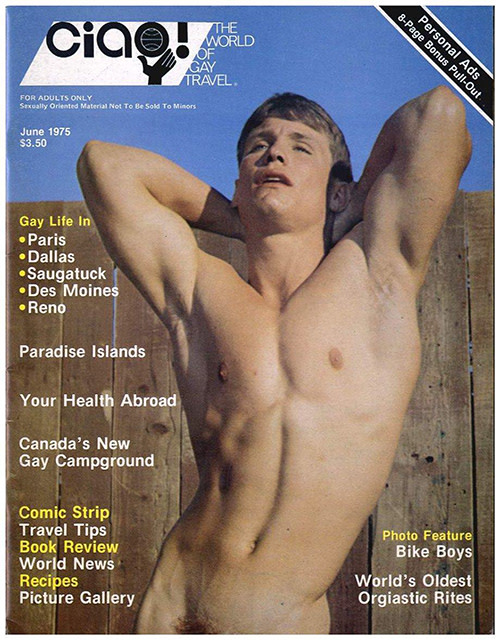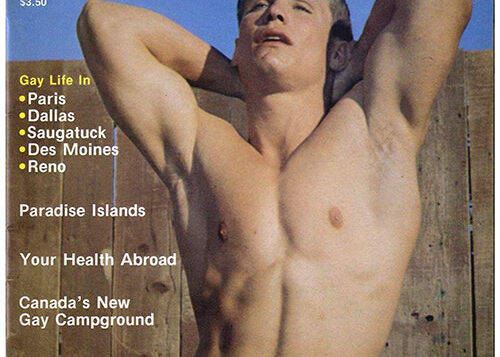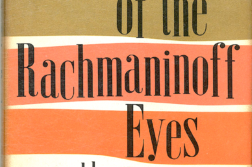CIAO! The World of Gay Travel was a bimonthly magazine published by George Desantis in New York City. Desantis had been a school teacher but lost his job when they found out he was gay. He was also denied an advanced degree from Purdue University “because he was a homosexual, [and]he was compelled to resign a university position he had already accepted” (per The Post-Crescent of Appleton, WI, June 28, 1970). Abandoning academia, Desantis decided to publish a proudly gay magazine, so he founded Queen’s Quarterly: The Magazine for Gay Guys Who Have No Hang-Ups (wisely renamed QQ the following year). Articles in the early issues were pretty tame (“Decorating a Stylish Apartment at Half the Cost” or a recipe for spaghetti and meatballs). As art director he hired Al Shapiro, better-known as the artist A. Jay, creator of the first gay cartoon, Harry Chess. Full-frontal nudity did not appear until the twelfth issue (December 1971).
The prolific display of male pulchritude led to brisk sales and profits, prompting Desantis to venture into other enterprises. He sold skimpy swimsuits and underwear, modeling these wares himself. He sold greeting cards; “Sex Combo” vitamins called Loravite, Vegerex and Dynavite; dildos and other “adult toys”; and a plethora of digest-sized magazines, including Tom of Finland’s Ringo & the Renegades, Gay Freedom and The Homosexual Health Guidebook. He also created the Mr. Fire Island Contest. In 1972, he ventured into the world of bodybuilders and their admirers with a larger magazine called Body.
 In February 1973, Desantis launched Ciao! The World of Gay Travel. He had always featured travel articles in QQ, but now they received prime billing. The premiere issue transported readers to Turkey, Munich, Mykonos, Capri, and San Francisco, delightfully accompanied by a plethora of naked men taken by professional studios such as Bruce of Los Angeles, AMG (Athletic Model Guild), and Western Photography Guild. Ciao! did historians a great service by documenting gay-friendly establishments, neighborhoods, and cruising areas, most of which no longer exist. Photographs of the entrances to old gay bars are particularly interesting. Craig Rodwell, gay rights pioneer and owner of the Oscar Wilde Bookstore, cowrote an article with Frank Keating on “gay dining” in Manhattan: “411 Bleeker St. Good food at moderate prices. Small and dimly lit. Linger with a lover or play kneesies with the humpy guy at the next table.” Desantis contributed an article on Puerto Rico in which he described The Annex bar as “a frustrating place for those who like to make a fast kill. … Puerto Ricans who frequent the place prefer dancing and ‘getting to know you first’ to being thrown in the sack for a quickie.”
In February 1973, Desantis launched Ciao! The World of Gay Travel. He had always featured travel articles in QQ, but now they received prime billing. The premiere issue transported readers to Turkey, Munich, Mykonos, Capri, and San Francisco, delightfully accompanied by a plethora of naked men taken by professional studios such as Bruce of Los Angeles, AMG (Athletic Model Guild), and Western Photography Guild. Ciao! did historians a great service by documenting gay-friendly establishments, neighborhoods, and cruising areas, most of which no longer exist. Photographs of the entrances to old gay bars are particularly interesting. Craig Rodwell, gay rights pioneer and owner of the Oscar Wilde Bookstore, cowrote an article with Frank Keating on “gay dining” in Manhattan: “411 Bleeker St. Good food at moderate prices. Small and dimly lit. Linger with a lover or play kneesies with the humpy guy at the next table.” Desantis contributed an article on Puerto Rico in which he described The Annex bar as “a frustrating place for those who like to make a fast kill. … Puerto Ricans who frequent the place prefer dancing and ‘getting to know you first’ to being thrown in the sack for a quickie.”
Editor-in-Chief John Lorrimer wrote: “Each month we expect to tell you about some particular city and its interesting people, its lifestyles, its gay ambience, its restaurants/ bars, its movies, baths and cruising areas and, in general, about what makes it tick, so that when you visit there you can start at 100 on the sexual-activity scale instead of zero.” Indeed, sex was the prevailing theme of Ciao!, reflecting the newfound freedom of gay men—or at least white men—during the hedonistic 1970s. Thirty-seven covers featured a white model, one had a Black model, and one was Asian. And despite the prevalence of the 1970s “clone,” only four issues sported men with mustaches.
Starting in the June 1975 issue, Ciao! added “Personal Ads,” which were free to all subscribers provided they limited themselves to thirty words. These ads reflected the wide diversity of its readers, but all had sex on their minds: “Cowboy Truckers and others traveling through Montana stop and visit John.” “Horny Vancouver warlock male witch hosts visiting horny studs.” “Italy. Companion/ Lover wanted. … Reasonably good-looking university professor. Interested in theatre, art, music, good food, conversation. Seek man 25-35 for company and sex.” “Slaves (M) wanted for live-in.” “Gay Detroit. Audubon-Naturist lover seeks the same. Let’s go birding or explore each other.” While most ads ventured into specific sexual desires (“passive Greek/ active French”), a few peeked through and revealed gay pain: “Lonely In Arkansas” and “Are You Lonely? Do you want someone to talk to who cares and will listen?” Still, in both its personal ads and its articles, Ciao! remained true to its mission of helping gay men who were interested in the thrill of having sexual encounters in gay travel spots throughout urban and rural America and around the world.
Along the way, Ciao! also advised its readers to savor good food at gay-owned and gay-friendly restaurants and to frequent popular gay bars where they could dance the night away. Drug use, which was certainly widespread at the time, was rarely mentioned. Readers were advised to watch certain movies and to attend the theater and even to read the occasional book. Also: to listen to singers other than Judy Garland and Barbra Streisand.
Reflecting its subscriber base, Ciao!’s content addressed a primarily white male readership. In my survey of issues from 1978, 62 articles centered on the U.S., with sixteen about California, New York, and Texas. Seven took us to Canada and four to Mexico. Europe had 32 reports, headed by Germany and France. Africa appeared only twice, while the three continents of Asia, Australia, and South America each received only one report.
In an attempt to compete with the popular annual gay guides of Bob Damron, QQ published Private Stock, a 144-page “International Travel Directory,” in 1979. Again, sex was in the foreground. Each destination was given an alphabetic code: H was for “Hustlers, rough trade, or S&M’ers,” K for “groping and sex,” O for “older crowd,” T for “toilet sex,” W for “local social information or legal [and]medical help,” and G (oddly) for “lesbians dominate.” Desantis thanked QQ readers for help in compiling the guide: “We especially want to thank you, our good friends who have sent us information on new discoveries—particularly ‘secret’ action spots.”
But changing times and powerful competition (Damron, Colt, Falcon) caused Desantis to say “ciao” to his entire business empire in 1980. Ciao! magazine, born alongside Stonewall in 1969, died with its 41st issue, March 1980, about a year before anyone had heard of Kaposi’s sarcoma, GRID, HIV, or AIDS. For approximately eleven years through his many business ventures, primarily through Ciao!, George Desantis offered gay men a sex-positive escape from the homophobia of American society, taking readers to places of acceptance and adventure near and far. For me and for many other gay men, those vintage issues of Ciao! that still reside on our bookshelves rekindle fond memories of a happy, exuberant time to be alive.
Frank Serafino lectures on LGBT history at the College of DuPage in Glen Ellyn, IL.






Discussion1 Comment
Great article; thanks for sharing. I’m currently preparing a class that touches upon Ciao magazine, and this has been helpful in adding context.